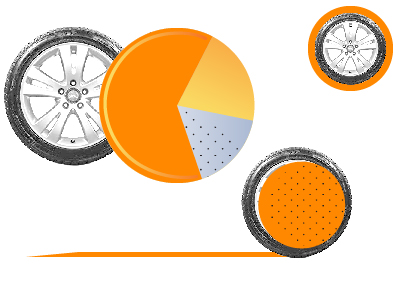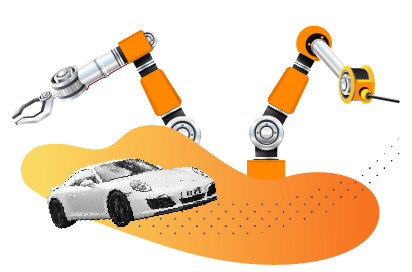Introducing You to AI in Automotive
The a
Smart Cars

The 1981 year became the pivot point for the world automotive industry when car manufacture engineers installed the first engine control unit (ECU) in a vehicle. Basically, we had the first computer in a car, which opened up plenty of development opportunities we continue to explore even today. It also brought us another transitional change in the industry with BMW introducing us to network connectivity in cars. Namely, in 1998 this car manufacturer launched BMW Assist Service software running on the embedded ina vehicle computer. Back then, that computer was as primitive as a mobile phone lying in a car and sending some data to the connected network. Nevertheless, cars having that Assist Service
These are:
- Driver assistants
Regardless of how impressive artificial intelligence in automotive has become, it’s still too early for us to fully rely on it in terms of humanless driving. As for the end of 2018, the most stable AI application in the car industry is the driving assistant software.
AI-based driver assistants bring massive changes to the navigation and safety measures on the road. Not only these make driving easier for inexperienced people but also enhance the communication between the car and its owner connecting them. Monitoring plenty of sensors, AI assistant can check blind zones, measure the exact distance to objects, and prevent emergencies from happening thereby saving lives on the road. For example, the consumer-facing part of driver assistance software can monitor driver’s behavior and tell if he has fallen asleep on the road due to his eyes being closed for too long or head bending down to his chest.
The best part about the car assistant software is that their functionality can be customized according to the driver’s needs. Ambulance, delivery trucks, public transportation services — each kind of driving has a lot of peculiarities, and AI has all of them covered.
- Autopilot driving
It’s been a while since car owners got used to relying on driver assistant software and started entrusting it their safety and wellbeing. However, the fact of cars becoming able to drive on its own turning the actual driver into a passenger is still shocking for many. Within the last few years, this idea made it from “a ridiculous fantasy” to “an inevitable reality” convincing even those who were the most skeptical or intimidated by that concept. So far, the two absolute leaders here are Waymo (used to be a part of Google) and Tesla.
Although the history proves that the idea of self-driving cars isn’t new, it’s only the rapid development in the field of machine learning and artificial intelligence made driverless vehicles possible. Of course, even with these two powerful technologies, the concept is still far from being perfectly stable. And it’s not just about the huge amount of data AI should process when driving, it’s also about the experience: anyone who has ever ridden a car knows that pressing the pedals and following the GPS tips is simply not enough. Hopefully, the advancement in AI autonomous driving tech stack and the high competition in this area will bring us some high-performing solutions in the nearest future.
Cloud

The foremost application of cloud services in the automotive industry is the car connectivity. A connected car is a car with internet access and WLAN on board. With that technology used, cars can connect to the network as well as each other, which brings a lot of extra benefits to drivers and all the road users in general. Add to this AI-driven software, and you’ll end up with the ultimate tool for car maintenance and even more.
- Planned maintenance
Car connectivity takes maintenance to a whole new level, which reaches far beyond the low-gas indicators and check-engine lights. With AI running in your car and checking on dozens of monitors and sensors, your car basically knows what is about to happen with this or that part of it.
AI-powered automotive software with cloud connection not just gather real-time data, but also stores it for analytics and statistics. In combination with permanent access to real-time updates that are recorded every single second, AI can detect activity that is impeding a car’s performance or analyze the potential failure scenario and prevent it. The best thing about it is that AI in your car software doesn’t complicate the user experience whatsoever. All the inner check-ins happen with no human interaction, and a driver would be bothered only in case you have to step up.
A great example of an automotive cloud is now under construction by Volkswagen and Microsoft. The two companies decided to team up to create the Volkswagen Automotive Cloud, which is promised to deliver the seamless experience to drivers while saving some natural resources and increasing road safety. The feature set is going to include driver identification, self-parking and charging, personal voice assistant, connection to smart home, etc.
- Individualized marketing
Personalization remains the it-word for a few years now, and even people far from advertising know that to make a marketing campaign successful, you need to distribute it to the right audience. That led to the race for user personal data turning the last one into the gold of the 21st century. Unfortunately, the line between breaking into user privacy and analyzing his/her marketing interests is so fine that companies and even governments are expressing their concern over safety and security of personal info hiding some parts of it from businesses. This puts companies into a position when they have to look for marketing channels that would not overwhelm their potential customers, and connected AI automotive assistants come in hand here.
Cloud platforms
Car Insurance

The insurance industry generates profits by predicting the future. Artificial intelligence in automotive spends a lot of time doing the same thing, although having in mind some other objectives. Naturally, people can greatly benefit if these two are combined in a business model.
- Risk assessment
Any wise insurance agent knows, to look through a driver’s history, health, and incomes isn’t enough to get the full picture of the risk he portrays for the insurance company. No
Having access to the most recent events in a driver’s life and analyzing his actions, artificial intelligence will find out if there’s anything threatening the future of this person. Risk profiles with AI-powered analysis in it are a lot more accurate since they take into account less obvious factors and do not focus on the past solely.
AI in Manufacturing
Robotics in manufacturing isn’t new to anyone these days, however, the AI applications at car manufacturing are not that spread yet. Pretty high costs are among the top reasons why this potent technology is affordable only for market leaders these days. However, the high competition in the automotive industry forces manufacturers to invest in better equipment and smarter solutions to enhance the quality of new releases without compromising the timing.
Similarly to warehouse management, the most high-end car manufacturers also use robots to collect, move, and sort items shortening the manual labor, as well as take part in vehicle assembly building. Also, robots are used in exterior works, like car painting and welding. In addition to following the pre-set algorithm, these robots can also detect inaccuracies and defects on the car surface. The technology behind smart robots is called Simultaneous Localization and Mapping (SLAM) — a computational method of constructing a map of an unknown environment and navigation in it. Implementation of robotics in the working routine of manufacture can decrease human labor by up to 70%, which would have a positive effect on the productivity of a manufacturer.
In addition to robots that are moving and working on their own, automobile manufacturers also explore the use of exoskeleton wearable industrial robots to protect

Summary
Long story short, artificial intelligence living in every vehicle will become our reality before you know it. Every single region demonstrates the shocking increase in the number of cars every year, e.g., Asia has 141% more cars than it has a decade ago. The more crowded are our roads, the higher are the risks of potential car crashes. The automotive industry of today cannot rely only on drivers being cautious and other road users taking every their step carefully. Artificial intelligence tech stack for every car is a significant step towards our safety and positive experience as of car users.



 (3 votes, average: 4.33 out of 5)
(3 votes, average: 4.33 out of 5)